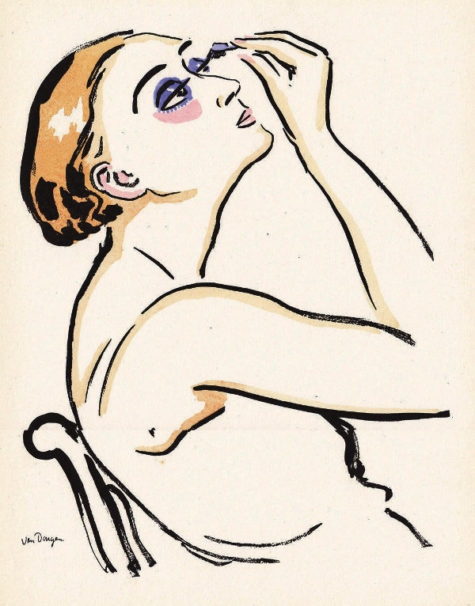
It was nice to hear from print specialist and art dealer Georgina Kelman who shares a fascinating explanation of these two prints. I bought a sassy Edgar Chahine etching (with drypoint) from Georgina a year ago.
Writes Georgina:
If you’re wondering what exactly a “pochoir” is, please don’t feel embarrassed. It is, without a doubt, the question I am most frequently asked. The (almost) lost art of pochoir is, in essence, a stencil technique that traces its origins to the Fifth Century and reached its peak in France during the 1910s – 1930s before fading into near obscurity as a victim of modernization and cost cutting.
At its most basic, the pochoir (pronounced “po-shwar”) printing process involves three main steps.
 First, the original illustration is analyzed and broken down into color fields. Often an etched or lithographic outline is made to serve as a register for the color applications that will follow. The cutting of stencils is the second step. Each color field requires a separate stencil, cut by the découpeur using a sharp knife on oiled cardboard, or fine sheets of zinc, copper or bronze. The third step involves applying pigment using a short stubby brush, called a pompon, to paint the gouache or watercolor through the stencil onto the paper.
First, the original illustration is analyzed and broken down into color fields. Often an etched or lithographic outline is made to serve as a register for the color applications that will follow. The cutting of stencils is the second step. Each color field requires a separate stencil, cut by the découpeur using a sharp knife on oiled cardboard, or fine sheets of zinc, copper or bronze. The third step involves applying pigment using a short stubby brush, called a pompon, to paint the gouache or watercolor through the stencil onto the paper.
The size of the brush, the method of application (dabbing, brushing, stroking, spraying) and the viscosity of the pigment itself all combine to give pochoir prints their trademark complexity of coloration, texture, shading and transparency. Finally the stencil is carefully removed to avoid smudging, the paint is allowed to dry and the print is passed down the assembly line to receive the next color application.
This is very painstaking process required skilled technicians and a lot of time. It was used primarily to print deluxe books and albums from fashion catalogues to livres d’artiste. With the crash of 1929 and the Depression, this expensive and labor intensive technique was replaced with seriography, color lithography and photogravure – all very lovely but lacking the richness and depth of hand applied paint.
“A versatile and beautiful medium!” says Georgina.
VAN DONGEN, Kees (1877-1968) Dutch, Le Rimmel – Femme se maquillant, (Juffermans JM1), 1920, Pochoir and lithograph
LEPAPE, Georges (1887-1971) French, Le Miroir rouge, 1919, Pochoir
Georgina Kelman :: Works on Paper | New York City, by appointment
